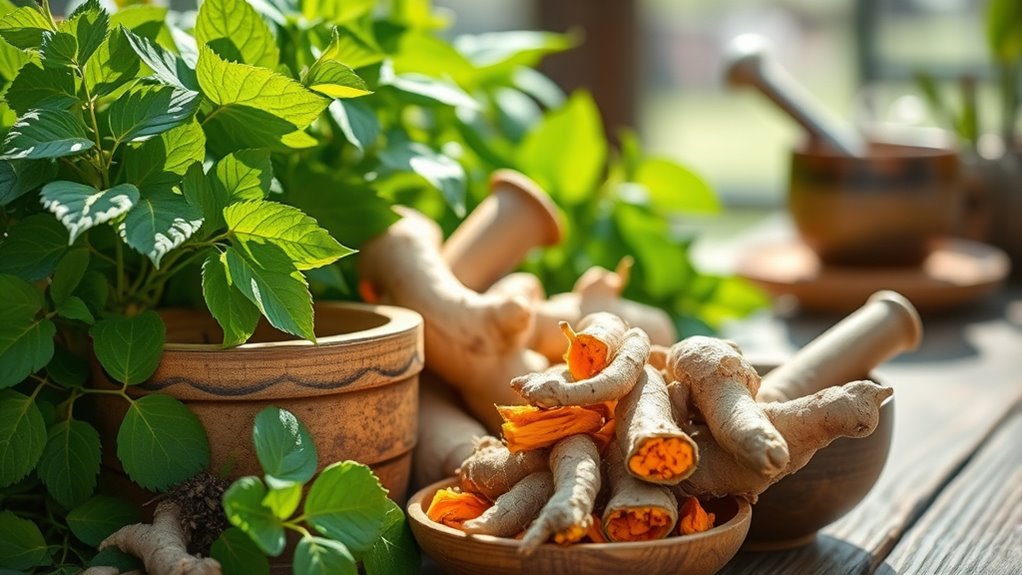To improve joint health naturally, focus on eating anti-inflammatory foods like fruits, vegetables, fatty fish, and herbs such as turmeric and ginger. Stay active with low-impact exercises, maintain a healthy weight, and practice good posture. Consider supplements like glucosamine or omega-3s, and use supportive footwear. Incorporate stress-reducing techniques and prioritize quality sleep. Keep exploring ways to support your joints for lasting relief and wellness.
Key Takeaways
- Incorporate anti-inflammatory foods like fruits, vegetables, fatty fish, and herbs into your diet.
- Maintain a healthy weight and stay well-hydrated to reduce joint stress and support lubrication.
- Engage in low-impact exercises such as swimming, cycling, and stretching to improve mobility and strengthen supporting muscles.
- Use natural supplements like glucosamine, chondroitin, turmeric, and omega-3s to decrease inflammation and joint pain.
- Practice good posture, proper lifting techniques, and incorporate stress management and adequate sleep for overall joint health.
Incorporate Anti-Inflammatory Nutrients Into Your Diet

To support joint health naturally, incorporating anti-inflammatory nutrients into your diet is vital. You should focus on eating plenty of fruits and vegetables, which boost overall health and help reduce inflammation. Fatty fish like salmon, mackerel, and sardines are rich in omega-3s, which can lessen joint stiffness and pain. Legumes provide antioxidants and fiber that combat inflammation, while whole grains supply essential nutrients for your overall well-being. Don’t forget herbs and spices—many contain compounds that help lower inflammation. Additionally, growing your own super seeds like chia can be a sustainable way to add nutritious, anti-inflammatory foods to your diet. Incorporating these nutrient-rich foods regularly can significantly improve your joint flexibility and reduce discomfort. Including plant-based proteins such as tofu and tempeh can also support joint health by providing alternatives that are gentle on your joints. When possible, choosing organic options may further reduce exposure to potential inflammatory agents, supporting your efforts for better joint health. Being mindful of inflammatory triggers in your diet can further enhance your results. By making these foods part of your daily meals, you can help prevent conditions like arthritis, support heart health, and lower your risk of developing chronic illnesses. Small dietary changes can have a big impact on your joint health over time.
Use Natural Supplements to Support Joint Function

Incorporating natural supplements can considerably boost your joint health efforts. These supplements target inflammation, improve lubrication, and support cartilage repair. For example, glucosamine and chondroitin help reduce pain and inflammation, while turmeric and ginger provide powerful anti-inflammatory effects. Hyaluronic acid maintains joint lubrication, and boswellia supports overall joint function. Omega-3 fatty acids like EPA and DHA also reduce inflammation and pain, promoting better movement. Here’s a quick overview:
| Supplement | Benefits | Sources |
|---|---|---|
| Glucosamine | Reduces joint pain and inflammation | Shellfish, supplements |
| Turmeric/Curcumin | Anti-inflammatory, pain relief | Spices, supplements |
| Hyaluronic Acid | Improves joint lubrication | Supplements |
| Boswellia | Supports joint health | Herbal extracts |
| Omega-3s | Decreases inflammation, pain | Fish oil supplements |
These natural options can support your efforts for healthier joints. Effective ingredients play a crucial role in achieving optimal results.
Engage in Targeted Exercise Routines for Joint Strength

Engaging in targeted exercise routines is essential for building joint strength and promoting overall joint health. You can strengthen the muscles around your joints, which helps reduce stress on cartilage and lowers injury risk. Low-impact activities like swimming and cycling improve circulation of synovial fluid, enhancing lubrication and nutrient delivery. Regular range-of-motion exercises increase flexibility and reduce stiffness, while strength training with resistance bands or weights builds supportive muscle mass. Incorporating balance and proprioception exercises decreases fall risk and joint injuries. Always start with low-intensity workouts, warm up properly, and use correct form. Avoid high-impact movements if you’re experiencing joint pain. Consistent routines, about 2–3 times weekly, help maintain joint function and lessen inflammation, supporting long-term joint health. Monitoring your exercise intensity ensures you don’t overstrain your joints and helps prevent setbacks. Incorporating protective strategies such as proper footwear or joint supports can further safeguard your joints during activity. Additionally, paying attention to joint mobility can enhance overall flexibility and reduce stiffness, leading to better joint function. Understanding the importance of proper technique can maximize benefits and minimize injury risks during exercise. AI safety measures are also important to ensure that technological tools used in health and fitness are reliable and secure.
Adopt Lifestyle Habits That Promote Joint Health

Adopting healthy lifestyle habits plays a vital role in maintaining and improving joint health. Keeping a healthy weight reduces stress on your hips, knees, and ankles, making daily movement easier and less painful. Even losing a small amount of weight can considerably benefit your joints. Focus on a balanced diet rich in omega-3s, antioxidants, vitamin D, calcium, and vitamin K to support joint function and reduce inflammation. Staying well-hydrated by drinking enough water maintains joint lubrication and cartilage health. Managing stress through relaxation techniques like yoga and meditation can decrease inflammation and joint discomfort. Additionally, incorporating best anime movies into your leisure time can provide a positive mental boost, helping to reduce stress levels. Finally, getting 7-9 hours of quality sleep allows your body to repair joint tissues and reduces inflammation, fostering overall joint well-being. These habits collectively promote healthier, more resilient joints.
Explore Alternative Therapies to Reduce Pain and Improve Mobility

Exploring alternative therapies can offer effective ways to reduce joint pain and boost mobility without relying solely on medications. Acupuncture and acupressure target specific points to stimulate healing and relieve discomfort. While results vary, many find relief through these traditional Chinese methods, but safety depends on practitioner skill. Herbal remedies like turmeric, ginger, and omega-3s have anti-inflammatory properties that may lessen joint pain. Hydrotherapy and aquatic exercises use water’s buoyancy to improve mobility with low impact, reducing stress on joints. Massage therapy can loosen muscles and enhance movement, especially when combined with heat or cold treatments. Additionally, mind-body practices like yoga, tai chi, and meditation help manage pain by improving flexibility, reducing stress, and fostering relaxation. These therapies can complement your overall joint health plan. Incorporating professional voiceover techniques into educational content can also improve engagement and understanding of these therapies. Moreover, understanding the philosophical insights on existence and ethics behind holistic health approaches can deepen your appreciation of alternative methods. Engaging in comprehensive health management strategies enables individuals to make more informed decisions about their joint health approaches. Recognizing the importance of nutritional strategies, such as anti-inflammatory diets, can further support joint care and reduce discomfort.
Practice Daily Habits to Protect and Preserve Your Joints

You can protect your joints daily by using proper lifting techniques to avoid unnecessary strain. Wearing supportive footwear helps reduce impact and stabilize your joints during movement. Additionally, maintaining good posture throughout the day minimizes stress on your joints and prevents long-term issues. Incorporating joint health strategies into your routine can further enhance joint preservation and comfort. Staying informed about sneaker culture trends, such as those influenced by Nike Tech, can guide you in choosing footwear that supports healthy joint motion. Participating in remote hackathons, such as Hack’n Jill, can also foster innovative approaches to health and wellness solutions that support joint health. Engaging in aquatic exercise can provide gentle yet effective movement options that benefit your joints without added strain. Exploring sound healing science may also offer complementary methods to reduce joint discomfort through relaxation and vibration therapy.
Use Proper Lifting Techniques
Have you ever considered how your daily lifting habits impact your joint health? Using proper techniques reduces stress and prevents long-term damage. For example, squat lifting involves bending your knees, distributing weight evenly. Here’s how different methods compare:
| Technique | Posture | Joint Impact | Suitability |
|---|---|---|---|
| Squat Lift | Bends at knees, keeps back straight | Low stress on hips and back | Heavy objects, safety focus |
| Stoop Lift | Bends at waist, keeps spine aligned | Moderate stress, risk of strain | Light to moderate lifting |
| Semi-Squat | Combines both, slight bend at knees | Balanced load, safer for joints | Versatile, common in daily tasks |
Practicing proper lifting builds muscle memory, protecting your joints from injury and chronic damage. Proper lifting techniques can also help maintain joint health over time.
Wear Supportive Footwear
Did you know that choosing the right footwear can substantially reduce joint stress and slow the progression of knee osteoarthritis? Specialized mobility shoes designed to lower knee loads can decrease peak external knee adduction moments by up to 12%, helping protect your joints. Flat, flexible shoes with low heels are especially effective, reducing dynamic knee loads during walking compared to stability or clog shoes. Proper support, cushioning, and stability in your footwear help distribute forces evenly, absorb impact, and improve gait, which lessens abnormal pressure on your knees. Wearing cushioned and supportive shoes not only alleviates pain but also enhances mobility and function over time. Incorporating local insights about proper footwear choices can further optimize your joint health. Adopting these footwear habits is a simple, non-invasive way to safeguard your joint health and prevent further damage.
Maintain Good Posture
Ever wondered how a simple change in daily habits can protect your joints? Maintaining good posture is key. It keeps your body properly aligned, reducing unnecessary pressure on your joints and preventing muscle imbalances that cause pain. When you stand with your feet shoulder-width apart and keep your back straight, you support healthy joint function and lessen the risk of injury. Sitting with feet flat on the floor and knees below hip level also helps. Regularly strengthening your core and back muscles, along with using ergonomic furniture, further promotes good posture. During activities, focus on maintaining proper form and balance. Incorporating awareness of posture’s impact on joint health can lead to better long-term outcomes. Over time, these habits reduce joint wear, prevent degeneration, and boost overall mobility, making your joints healthier and your movements more comfortable.
Frequently Asked Questions
Are There Specific Foods That Can Help Prevent Joint Degeneration?
You want to prevent joint degeneration, so focus on foods rich in anti-inflammatory compounds. Incorporate cherries, blueberries, and red grapes for anthocyanins, and eat plenty of leafy greens like spinach and kale for vitamin K. Use olive oil instead of other fats, and include oily fish like salmon for omega-3s. These choices help reduce inflammation, support cartilage health, and may slow degeneration over time.
How Long Does It Take for Supplements to Show Joint Health Benefits?
Imagine you start taking glucosamine today; some people notice relief within a few weeks, but for others, it might take several months. Typically, supplement benefits vary based on factors like dosage and individual response. Consistency is key—taking them regularly and combining with a healthy lifestyle can speed results. So, patience is essential, and long-term use often yields the best improvements in joint health.
Can Exercise Worsen Joint Pain if Not Done Correctly?
You might wonder if exercise can worsen joint pain if not done right. It definitely can. Using poor technique, overexerting, or skipping warm-up and cool-down increases joint stress and inflammation. High-impact or intense workouts without proper guidance can damage already compromised joints. To avoid this, focus on low-impact activities, listen to your body, and consider professional advice to tailor exercises that support, not harm, your joint health.
What Are the Best Ways to Reduce Joint Inflammation Naturally?
You might worry that reducing joint inflammation could limit your activity, but the right approach actually helps. Focus on anti-inflammatory foods like turmeric, ginger, and omega-3 rich fish, and incorporate the Mediterranean diet. Regular low-impact exercise, heat or cold therapy, and stress management also play a role. Staying hydrated, maintaining a healthy weight, and avoiding processed foods can markedly reduce inflammation, easing joint pain naturally and safely.
Is It Safe to Combine Multiple Natural Therapies for Joint Pain?
You might wonder if it’s safe to combine multiple natural therapies for joint pain. It can be, but only if you consult healthcare professionals first. Combining practices like yoga, acupuncture, and herbal supplements can boost benefits, but watch for possible interactions or side effects. Start slowly, monitor your response, and make certain each therapy suits your condition. Always prioritize professional guidance to safely maximize joint health benefits.
Conclusion
By making these natural changes, you can markedly improve your joint health and mobility. Incorporating anti-inflammatory foods, staying active, and adopting healthy habits can reduce pain and enhance your quality of life. Did you know that regular exercise can decrease joint stiffness by up to 30%? Taking small, consistent steps today can lead to long-term benefits, helping you stay active and pain-free for years to come.









